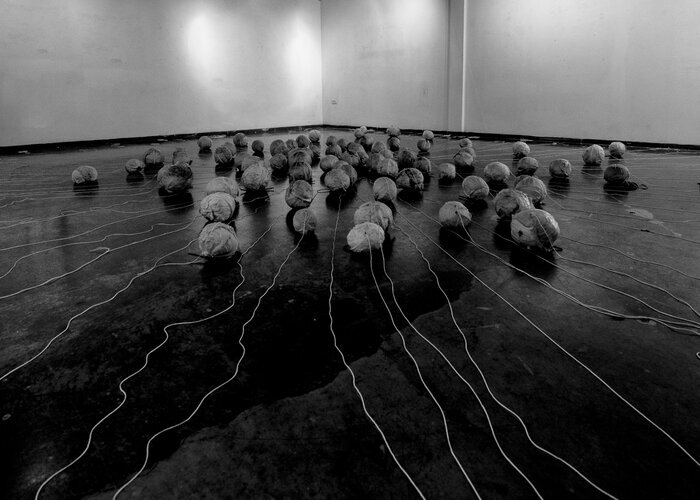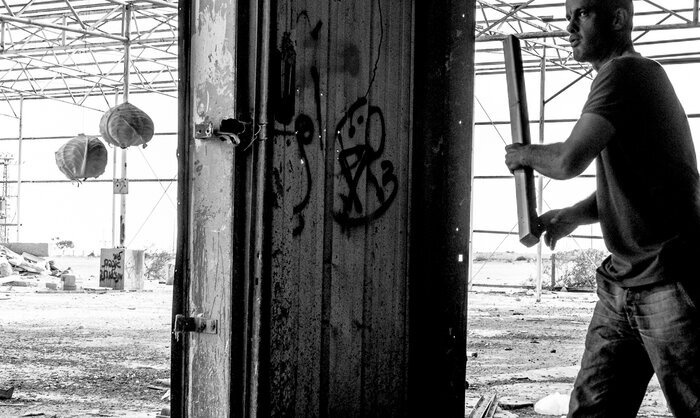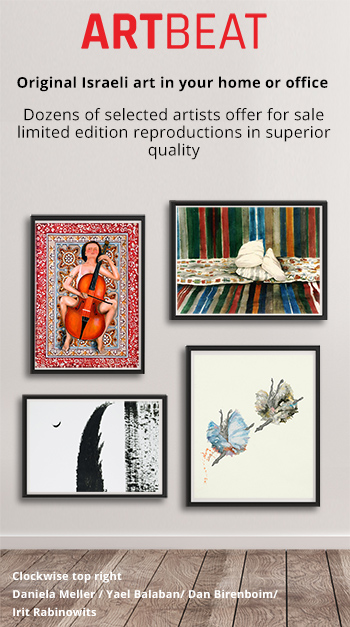Art Shows > Nurit Agur - Angels and Fools
Nurit Agur - Angels and Fools / Zaritsky Artists Houseטלפון - 03-5246685 17/02/2022 to - 12/03/2022 part 1 of 3p ices text by Albert Swissa
"Angels and Fools, from Darkness to Light and Back…
Before us is a special, maybe slightly frightening spectacle: A field of cabbages, hanging on the verge as if swooning, some of the vegetables lit with a projector light that projects, through them and on the wall, a meditative Zen video in black and white. A Quixotic warrior’s image appears on the wall, in civilian clothes, moving slowly as in a Tai Chi dance, pointing his weapon against hallucinatory presences, still invisible. Slowly, the cabbages suspended in space, at eye level and slightly below it, seem to be moving, in a Tetris-like menacing hover, penetrating the space of the warrior’s sword, charging at him. At the same time, we can imagine the mysterious warrior, who is now striking at the cabbages shot at him, bouncing from the wall and landing in the space of the hovering cabbages, silently, before the final decisive battle, to smash and shatter the cabbage idols. The atmosphere in this space is charged and strange. This is not a straight, stoic field of cabbages planted in the earth, calmly stretching to the horizon. The fact that they are “suspended” reverberates a sense of something “pending”, an energy which may, at any moment, manifest and shake this space.
Supposedly, if we just avoid touching the cabbages, nothing will happen. But as we carefully walk between the silent cabbages that stare back at us from the dark, marked only in the Sisyphean movements of the warrior on the wall, we sense that the space is being charged with the strange, prehistoric energy of this “domesticated” ancient vegetable, whose wild ancestors still grow in the wildernesses of our lives, as if to say, “what has been will be again.” We observe the cabbages of our lives, wondering which among them are fools and which are angels, which have spread their wings and which have rotted and shed their skin to the earth long ago. We strive to understand what it is in this dull vegetable that captivated so many artists, from ancient times to the present day, and why did Agur invite us to watch her private, singular duel with the cabbages: Who is her agent, this warrior on the wall? Where did he come from? Who or what is it that she is fighting?
Indeed, art offers many ways to contemplate a cabbage. Agur’s way should be interpreted based on the corpus of her extensive work, which has not been seen for many years. It is now the time to pull the key thread out of the unraveled cocoon (or “rhizome”), her labor and creation in various formats, and to try and hold it at both ends. This tension between labor and art, between the repetitive Sisyphean motion of daily life, the rare moments of grace, the epiphany of the work, is what first comes to surface, in Agur’s completely intuitive choice of the cabbage. The cabbage, after all, is representative of the direct simplicity of men of action, the ascetic austerity of the idealistic pioneers who were her parents. Its resilience and vitality over time, especially when pickled, brings to mind spartan frugality, experienced worldliness, dullness, perhaps even thrift. Cooked cabbage is a symbol of a house in mourning, or the house of the deathly ill. Its sulfuric odor, when cooked at home, sticks to everything with its murky yellowness, not to mention its sudden, unbearable stink when left to rot, a stench reminiscent of the body’s decay, or as the Italians say “go the way of the cabbage (the way of the flesh)”, a proverb referring to a person about to die or who has recently passed away. Thus, the bowl of effervescent youth is violated with a sense of sticky, revolting intimacy, forced by the mother on a little girl who escapes to her room, to shut herself away from this cabbage life. In her isolation, in the kitchen, the wife/mother cooks cabbage, uniting the entire family under a smell reminiscent of sour body odors, and the husband/father eats away, silently instructing his family. Then, at the bequest of the sowing and cooking mother, the father gets up and sits his daughter down forcefully next to the table, to teach her self-restraint. It is hard to imagine, therefore, the joy of the family gathering around the bowl of cooked cabbage. On the contrary, we can imagine the silence of those who scorn children’s babble and their playful, creative indulgences of the imagination. This is how the cabbage became for Agur a symbol of demanding toil and routine, that come with a hushed silence, with suppression and shushing, as well as volatility and a false mindset, as everyone chews away joyless and silent, and no one dares say what’s on his mind, with his mouth full of pickled cabbage. Agur now comes to term with the cabbage, which represents the meaninglessness and unimportance of the tiring mass of life that we carry on our shoulders every single day, by turning the cabbage of life into a creative act – the spectacle of cabbages, which is in a way a cruel theater of the absurd."
location - Zaritsky Artists House Time - 17/02/2022 to - 12/03/2022 Exhibition opening - 17/02/2022 ארוע הפתיחה החל מהשעה 19:00 |
The content appearing on this page and the details of this exhibition are shown on the behalf of the advertisers and on their responsibility.
All rights reserved to - artbeat.co.il © Israel Art
|1|



